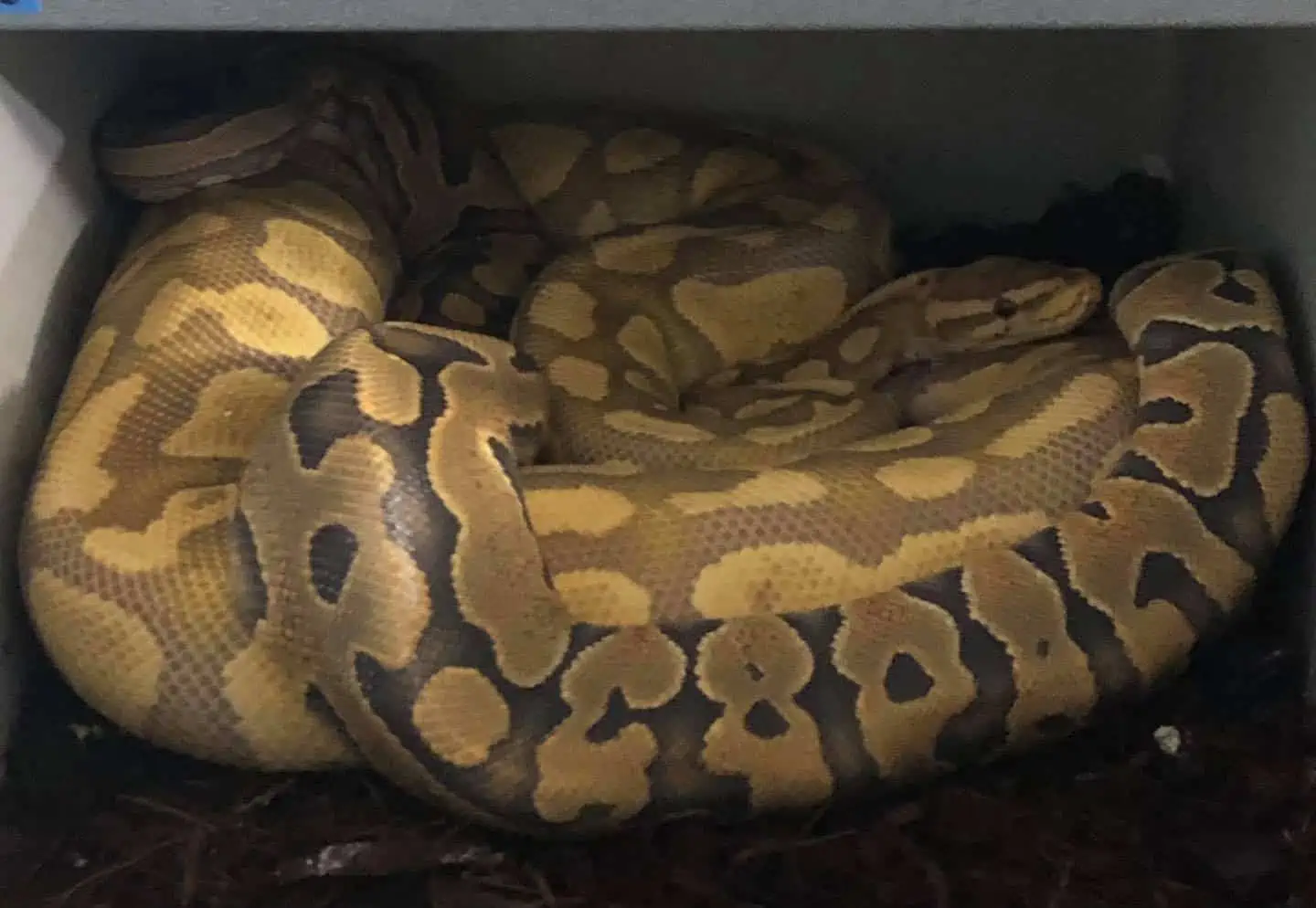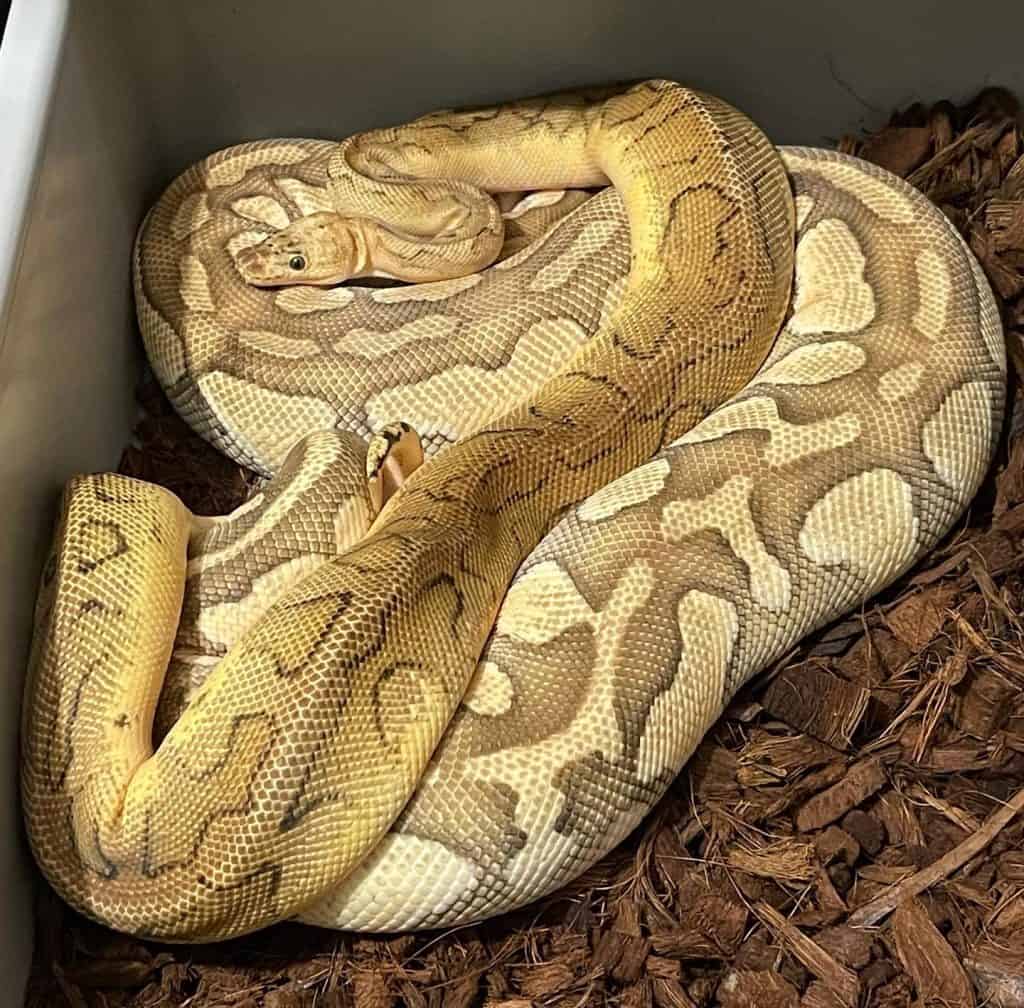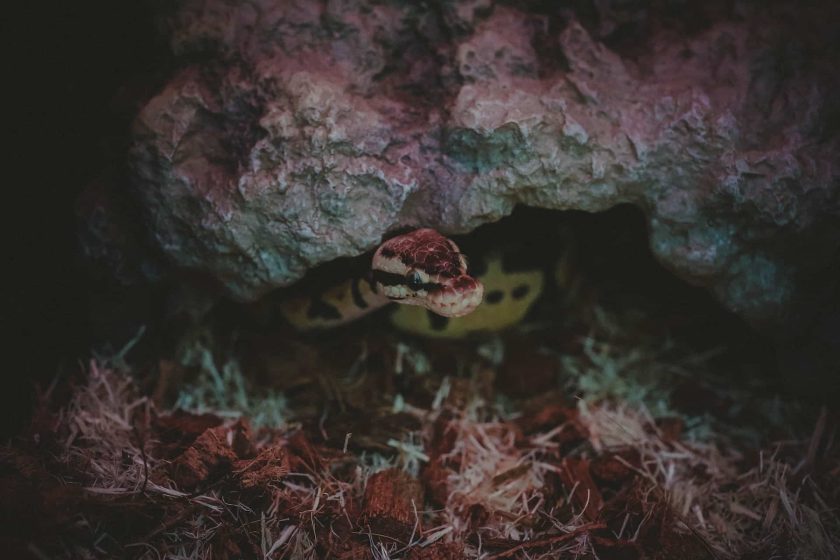Ball pythons are nocturnal creatures known for hiding and burrowing in the wild. They have an impressive ability to fit into small cracks, crevices, and tunnels, making them adept at both concealing themselves from predators and also seeking out prey. Surprisingly enough, ball pythons don’t just hide in their natural environment; they also exhibit this behavior when kept as pets in captivity.
If, however, your ball python chooses to remain in its enclosure for an extended period of time, there may be additional elements involved affecting this behavior, such as:
- Brumation
- Poor handling
- Sickness
- Stress and anxiety
- Unsuitable temperature
- Too large enclosure
- Shedding
- Sleeping
- When digesting meal
- Feeling threatened
Depending upon the condition, ball pythons can stay hidden for up to several days or even weeks until the problem is solved. To ensure that your pet snake remains healthy, safe, and happy in its home, it is important to identify the reasons why it may be hiding and take the necessary steps to rectify them.
In this article, we’ll explore the causes of why ball pythons may hide and provide tips on deterring such behavior.
Is It Normal for a Ball Python To Hide?
Ball pythons are creatures of the night and remain largely secretive during daylight hours. In their native Africa, they often take residence in burrows left behind by other animals. By nature, these snakes spend much of their time hidden away from sight – making them an elusive species indeed!
To remain safe from becoming prey, they stay hidden during the day and come out at dusk and night to hunt for food. It ensures that these animals have a better chance of survival while avoiding exposure to the heat of the day.
Pet ball pythons typically act according to the same patterns in captivity, exhibiting normal behavior that aligns with their natural inclinations.

Other Reasons Why Your Ball Python Is Hiding
Besides its natural instinct, several other elements can be responsible for your snake’s frequent hiding. Delving into these variables can help you better understand your reptile’s behavior.
1. During Brumation
As the weather cools and winter arrives, snakes enter a dormancy called Brumation. This type of hibernation is exclusive to cold-blooded animals such as reptiles – unlike other creatures who remain in slumber for months at a time, these critters can still maneuver around their habitats and drink water during this period.
However, they are not quite as active compared to summertime; additionally, it’s common for them to become uninterested in food altogether until warmer temperatures return.
Brumation in captive ball pythons is also common; during this period, your python may become less active and more inclined to spend time in its hide box.
In this case, these reptiles may take refuge inside their hide even if there is an area within their enclosure with the appropriate warmth for them to live comfortably. They will remain dormant until they feel winter has passed and consequently begin coming out of hiding again.
2. Bad Handling
Poor handling of ball pythons can cause them to retreat into their enclosure and refuse to come out. When handled too roughly, ball pythons may become stressed and defensive and seek a safe place to hide away from potential threats. This is the case when:
- Handling your snake in the morning or afternoon while it should be asleep is inappropriate.
- Doing so before they’ve had time to adjust to their enclosure can prove incredibly stressful.
- Additionally, it is essential to move your hands in unison with a snake’s movements; otherwise, attempting to guide the creature against its will only cause undue stress.
A snake that is frequently handled will feel threatened by any unfamiliar movements or environmental changes, such as loud noises or sudden movements.
3. When Regulating Body Temperature
Snakes are cold-blooded, meaning they require thermoregulation. To warm up, they bask under the sun and move to a cooler area when they need to cool down. That’s why most enclosures have both warm and cool spots – so your snake can appropriately balance their temperature levels; one of these areas is typically where owners place the hide box for added comfort. However, I suggest pet parents place hides in both hot and cold regions rather than just one or another for optimal thermoregulation.
If your snake has been staying coiled up in its hide for an extended period, it’s best to inspect the temperatures of both warm and cool spots. Perhaps one of them isn’t at an adequate number, so your pet may be trying to adjust by living inside instead.
4. Incorrect Enclosure Size
When your snake is in hiding for extended periods, it could be a clue that the enclosure may be too spacious. After all, snakes are predators and prey animals, too, who need to feel secure in their cages. They won’t feel at ease if they’re overexposed and lack adequate cover or hides. To ensure that your pet feels comfortable with you – I urge reptile owners to invest more effort into providing them with suitable accommodations!
Adding natural and/or artificial foliage can help provide needed cover while maintaining correct temperatures as per species requirements will keep them calm and contented.
5. When Stressed Due to New Environment
If your newly acquired snake is in hiding for an extended period of time, don’t worry! It’s just a normal part of their adaptation process; snakes must feel safe and secure to explore their new home effectively. They’ll be surveying the area from a place of security so they can figure out where food sources are located and if there are any potential threats around them.
With some patience, you’ll soon see your slithery companion venturing out – giving you plenty of opportunities to bond with them!
6. Sleeping
Snakes can sleep for extended periods, especially after devouring a hearty meal or when most active at night. For safety reasons due to their wild predecessors’ instincts, even pet snakes will slumber in secure hideaways to make themselves less accessible and vulnerable to potential threats that could harm them if they were sleeping uncovered.
While it may be hard to tell since snakes do not have eyelids, your snake might just be fast asleep in its hiding spot.
7. Shedding
When ball pythons shed their skin, they become less active and hide in their enclosure. This is due to the fact that shedding can be uncomfortable and uses a lot of energy & time to accomplish. Furthermore, while they are in the process of shedding, they often experience a loss of vision as well as vulnerability due to the thinning of the skin. As a result, ball pythons prefer to take refuge in their enclosure until the shedding process is completed.
After the molting process is complete, your slithery companion will return to its normal energy and activity level.
8. Suffering From Illness
Illness can cause ball pythons to hide in their enclosure to seek protection. When your normally energetic snake begins unexpectedly seeking seclusion for longer than usual, it is likely a sign of illness. They may not necessarily want to withdraw from their environment, but they instinctively try to conserve their energy and protect themselves from any potential danger.
In addition to its illness, a snake may display other signs of distress – therefore, I advise you to keep an eye out for any abnormal behavior or physical problems and take the necessary steps to address them.
9. Digesting Its Food
After consuming its prey, a snake typically returns to its shelter to digest the meal. Snakes swallow their food without chewing it first, so their digestion takes much longer than other animals. This means that snakes use large amounts of energy & time while breaking down their food, causing snakes to feel sluggish and vulnerable during digestion as they cannot move swiftly due to their weakened state.
So don’t be concerned if you find your ball python lounging in his hiding spot for an extended period after eating. He needs time to gain energy from the meal before he can move on!
10. Feeling Insecure
Your snake may feel insecure, which may explain why it hides inside its enclosure even after being fed. If you’ve noticed this behavior – sneaking away and not reappearing until the next mealtime – then chances are you haven’t established a regular routine for handling or feeding yet.
When a snake feels vulnerable and insecure, it often reacts with swift defence mechanisms such as hissing or striking when its enclosure is opened. This behavior stems from fear and the need to protect itself.
To ensure your pet feels safe and comfortable in both its home and with you as its guardian, I encourage pet parents to try to socialize more often!

How Long Can a Ball Python Hide?
While waiting for your slithering friend to come out of its hiding place may be disheartening and tiresome, don’t assume you can wear them down. Snakes are naturally patient animals and can stay hidden in their burrows for hours, days, or weeks, depending on the situation.
- When ball pythons are in the process of shedding, they may retreat to their hideouts for up to two weeks until it is finished.
- Snakes that are active at night generally remain concealed in the daylight hours and come out to hunt when darkness falls.
- In instances where your snake feels uneasy, it may take many weeks to construct a secure bond with the cage and you as its owner before coming out of hiding.
How Can I Stop My Ball Python From Hiding?
To break your snake’s hiding habits, the initial step is to discover why it needs to be hidden. If your pet is shedding, sleeping, or digesting food – you just have to wait until they are done with those activities.
However, if these aren’t the reasons behind their desire for shelter, I recommend taking the following steps to stop them from seeking seclusion.
- If you recognize that your snake’s hiding behavior is rooted in unrest and unease, then regular handling training may help assuage this anxiety.
- If your pet snake feels too exposed, adding more hides to the enclosure can make them feel secure and much more likely to emerge from hiding.
- Additionally, always keep the temperature settings in their cage at an optimal level to minimize hiding behavior.
- Try offering fresh food in their enclosure so they will come out to eat when hungry; you can gently use tongs or sticks to entice your ball python out of its hiding spot.
- Finally, make sure that you are not overhandling your snake. Too much handling can cause increased anxiety and result in more hiding.
By following these simple guidelines, you can help reduce the amount of time your ball python spends in hiding and create a happier, healthier home for your pet.
Final Thoughts
It is clear that when a ball python hides, it can be due to various reasons. At times, this behavior can be simply attributed to their natural instinct; other times, their environment may need adjustment, or they may not feel comfortable in the presence of humans. It is important for reptile keepers to observe and understand their pet’s cues and make necessary changes to ensure their pet’s well-being.
Do you have a ball python that is hiding? How did you address this behavior? What tips would you share with other reptile owners who are having similar issues? Share your advice in the comments section below!



2 Comments
I just got my baby ball python yesterday. She went around the enclosure probably 20 times and then she just curled up into a ball on the warm side. I put a hide over her because I thought it would help her feel more secure and I wasn’t sure if she recognized she could go in there. I’ve been checking her warm/cold temperature every other hour or so. Hope I’m not scaring her!
Hi Diane,
Congratulations on your new ball python! It’s completely normal for a new snake to explore and then curl up as they are getting used to their new environment. Give her some time to adjust. It’s great that you are monitoring the temperatures. It’s also crucial to limit handling and disturbances during this adjustment period.
Regarding the hide, it’s good that you placed one over her. She might still be figuring out her new space. Continue to ensure that her enclosure has the appropriate heat, humidity, and hiding spots, and she will likely begin to use the hide on her own.
Be sure to check out our Ball Pythons Guide. It’s filled with useful information to help you and your python get acquainted and thrive together.